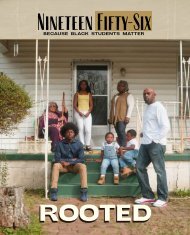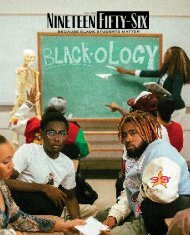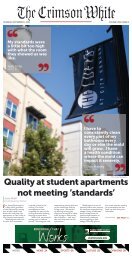Create successful ePaper yourself
Turn your PDF publications into a flip-book with our unique Google optimized e-Paper software.
Domestic violence and sexual assault<br />
have long been some of humanity’s most<br />
heinous crimes, the kind that could only<br />
be whispered about behind closed doors,<br />
but because of recent cultural shifts,<br />
they’ve recently been exposed like never<br />
before. Countless celebrities and public<br />
figures such as film producer Harvey<br />
Weinstein and former Alabama Senator<br />
Roy Moore have been accused of sexual<br />
assault and are actually facing backlash<br />
for their alleged actions—a welcomed<br />
relief from the past when practically<br />
all victims were dismissed and seen as<br />
unreliable, deceitful and desperate for<br />
attention. Although many are still met<br />
with doubt and criticism, more people<br />
see their accusations as valid and call<br />
for an appropriate response from higher<br />
authority. As society becomes more<br />
aware of domestic violence and sexual<br />
assault, and less critical of victims who<br />
choose to share their stories, more<br />
people feel safe calling out their abusers<br />
and demanding consequences, as they<br />
should.<br />
But how have current shifts in society<br />
and social media changed the way we view<br />
these issues?<br />
There’s been an intense movement<br />
to erase the stereotype of sexual assault<br />
as being only committed by evil men<br />
in the night who wear trench coats<br />
and ask pretty girls to help them get<br />
into their cars. Based on staggering<br />
statistics, it’s not just something you<br />
hear about happening to your brother’s<br />
best friend’s coach’s daughter either.<br />
With 321,500 annual victims of rape<br />
and sexual assault in the US (85 percent<br />
of which are committed by people the<br />
victims knew before the attack), you’re<br />
overwhelmingly likely to know not only<br />
someone who has been a victim, but<br />
somebody who has committed the act.<br />
The #MeToo movement that went viral<br />
in October 2017 was actually started in<br />
2006 by social activist Tarana Burke,<br />
encouraging women—especially from<br />
underprivileged communities—to share<br />
their experiences of sexual assault. The<br />
overwhelming number of tweets, posts<br />
and statuses from victims has made<br />
it clear: Sexual assault is pervasive,<br />
insidious and cannot be swept under the<br />
rug any longer.<br />
There has also been a shift in the<br />
way male victims are perceived. Actor<br />
Terry Crews came forward in October<br />
of 2017 about Hollywood executive<br />
Adam Venit groping him during a public<br />
event in 2016. Actor and singer Anthony<br />
Rapp spoke out about Kevin Spacey’s<br />
unwanted sexual advance toward him<br />
that occurred in 1986, when Spacey was<br />
26 and Rapp was only 14. Less recently,<br />
Emma Roberts was arrested in 2013 after<br />
attacking her then-fiancé, actor Evan<br />
Peters, in their hotel room in Vancouver<br />
and leaving him with a bloody nose and<br />
a bite mark. It’s been public opinion for<br />
far too long that men and boys can’t be<br />
victims of these crimes, but that tide<br />
is turning. Even if the totem pole of<br />
sociopolitical power often puts men<br />
over women in positions where they can<br />
easily abuse their authority, women can<br />
be abusers, and men can abuse men,<br />
52 <strong>Alice</strong> Spring 2018


















